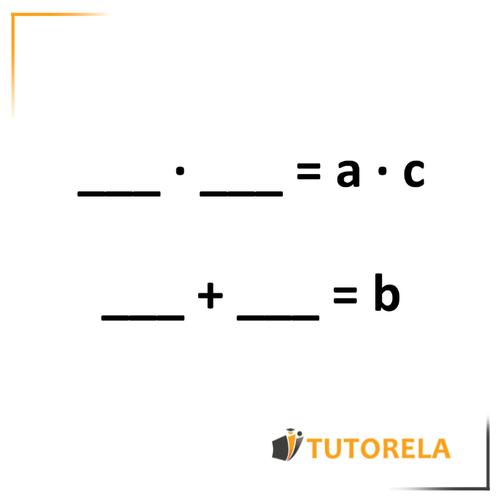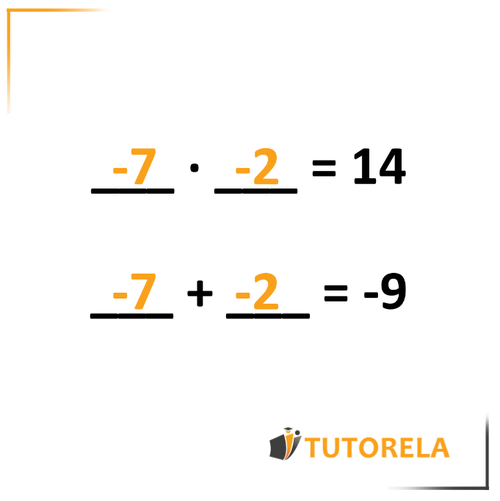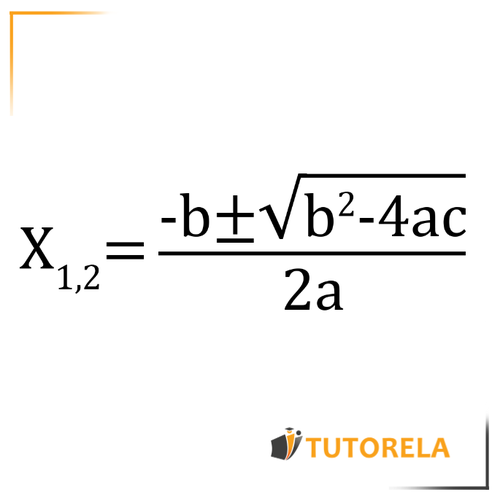In this article, we will learn the three most common ways to solve a quadratic function easily and quickly.
Methods for Solving a Quadratic Function
Methods for solving a quadratic function
- Trinomial
- Quadratic Formula
- Completing the Square
Reminder:
The basic quadratic function equation is:
When:
- the coefficient of
- the coefficient of
- the constant term
- must be different from
- or can be
- can be negative/positive
- The quadratic function can also look like this:
Test yourself on solving quadratic equations!
What is the value of X in the following equation?
\( X^2+10X+9=0 \)
How do you solve a quadratic function using trinomial?
Find numbers that satisfy the following two conditions:
How do we proceed?
First of all, let's write down on the side:

Then–
- We will find all the numbers whose product is and write them down.
- We will check which pair of numbers from the pairs we found earlier will give us the sum .
- We will write the pair of numbers that meets the conditions in this form:
or with subtraction operations. - solutions of the quadratic equation will be those that solve the equation above (we will reverse the sign for the pair of numbers we found)
Tip – It is recommended to use the trinomial method when
For more reading and practice on trinomials, click here!
And now let's practice!
Solve the quadratic function in front of you using trinomial:
Solution:
First of all, let's write down on the side:

Let's find all the numbers whose product is (and remember the negative numbers as well)
We get:
Now, let's check which pair of numbers from the pairs we found earlier will give us the sum (-9)

The pair of numbers that managed to meet both conditions is
We write the factorization:
The solutions:
How do you solve a quadratic function using the quadratic formula?
Meet the quadratic formula:

All you need to do is arrange the parameters of the quadratic function, substitute into the equation once with a plus and once with a minus, and find the solutions.
To learn more about the quadratic formula, click here!
Let's practice!
In front of us is the quadratic function:
Let's solve it using the quadratic formula:
First, let's arrange the parameters:
Now, we substitute into the quadratic formula:
For the first time with plus-
The second time with minus:
We got solutions –
Solve for X:
\( -2X^2+6X+8=0 \)
Solve the following equation:
\( x^2+5x+4=0 \)
Solve the following equation:
\( x^2+9x+8=0 \)
How do you solve a quadratic function by completing the square?
To use the method of completing the square, let's recall some of the formulas for the shortened multiplication:
Solution method with example:
Here is the function
- Let's look at the quadratic function and focus only on .
For now, we'll ignore . In the example, we'll focus on - Let's recall the formulas for completing the square and ask, what expression can we put inside the parentheses squared, that is, which or as relevant, that will give us what appears in the pair we focused on
In the example-
The appropriate formula for completing the square is:
Let's ask, what should we put as and to get ?
The answer is -
Let's expand this expression according to the formula for completing the square and get:
- Note that the expression in parentheses also brings with it a certain number and not just the pair we focused on, so we will need to cancel it.
If the added number is negative, we will add it to the equation to cancel it, and if the number is positive, we will subtract it from the equation to cancel it.
Additionally, we will return to from the original function and write it in the equation as well.
In the example:
The number was added. To cancel it, we will subtract and not forget the original
- We will substitute the pair with the appropriate expression in parentheses squared that we found and arrange the equation – we will get the completion of the square.
In the example:
Now let's set the equation to 0 and solve:
and also
Solution 1:
Solution 2:
For more information on completing the square, click here!
Solve the following equation:
\( 2x^2-10x-12=0 \)
Solve the equation
\( 3x^2-39x-90=0 \)
Solve the following equation:
\( -2x^2+22x-60=0 \)
Examples with solutions for Solving Quadratic Equations
Exercise #1
What is the value of X in the following equation?
Video Solution
Step-by-Step Solution
To answer the question, we'll need to recall the quadratic formula:
Let's remember that:
a is the coefficient of X²
b is the coefficient of X
c is the free term
And if we look again at the formula given to us:
a=1
b=10
c=9
Let's substitute into the formula:
Let's start by solving what's under the square root:
Now we'll solve twice, once with plus and once with minus
And we can see that we got two solutions, X=-1 and X=-9
And that's the solution!
Answer
Exercise #2
Solve for X:
Video Solution
Step-by-Step Solution
To solve the quadratic equation using the quadratic formula, follow these steps:
- Step 1: Calculate the discriminant, .
Here, , , and . Plug these into the formula: Since the discriminant is greater than zero, the roots are real and distinct.
- Step 2: Apply the quadratic formula, .
Substituting the values, we have: Simplifying inside the square root gives us: This leads to two possible solutions: - First, calculate with the positive square root: - Second, calculate with the negative square root:
Thus, the solutions to the equation are and .
Verifying against the choices, the correct choice is:
Therefore, the solution is .
Answer
Exercise #3
Solve the following equation:
Video Solution
Step-by-Step Solution
The parameters are expressed in the quadratic equation as follows:
aX2+bX+c=0
We substitute into the formula:
-5±√(5²-4*1*4)
2
-5±√(25-16)
2
-5±√9
2
-5±3
2
The symbol ± means that we have to solve this part twice, once with a plus and a second time with a minus,
This is how we later get two results.
-5-3 = -8
-8/2 = -4
-5+3 = -2
-2/2 = -1
And thus we find out that X = -1, -4
Answer
Exercise #4
Solve the following equation:
Video Solution
Step-by-Step Solution
To solve the quadratic equation , we will use the factoring method because it appears simple to factor.
First, we attempt to factor the quadratic expression . We look for two numbers that multiply to 8 (the constant term) and add up to 9 (the coefficient of the term).
These numbers are 1 and 8. So, we can write:
Now, to find the solutions, we set each factor equal to zero:
- →
- →
Therefore, the solutions to the equation are and .
Upon reviewing the multiple-choice answers, we find that the correct choice is the one that matches our solutions:
Answer
Exercise #5
Solve the following equation:
Video Solution
Step-by-Step Solution
Let's recall the quadratic formula:

We'll substitute the given data into the formula:
Let's simplify and solve the part under the square root:
Now we'll solve using both methods, once with the addition sign and once with the subtraction sign:
We've arrived at the solution: X=6,-1
Answer
More Questions
The Quadratic Formula
- Quadratice Equations and Systems of Quadraric Equations
- Quadratic Equations System - Algebraic and Graphical Solution
- Solution of a system of equations - one of them is linear and the other quadratic
- Intersection between two parabolas
- Word Problems
- Properties of the Roots of Quadratic Equations - Vieta's Formulas
- Ways to represent a quadratic function
- Various Forms of the Quadratic Function
- Standard Form of the Quadratic Function
- Vertex form of the quadratic equation
- Factored form of the quadratic function
- The quadratic function
- Quadratic Inequality
- Parabola
- Symmetry in a parabola
- Plotting the Quadratic Function Using Parameters a, b and c
- Finding the Zeros of a Parabola
- Methods for Solving a Quadratic Function
- Completing the square in a quadratic equation
- Squared Trinomial
- The quadratic equation
- Families of Parabolas
- The functions y=x²
- Family of Parabolas y=x²+c: Vertical Shift
- Family of Parabolas y=(x-p)²
- Family of Parabolas y=(x-p)²+k (combination of horizontal and vertical shifts)









